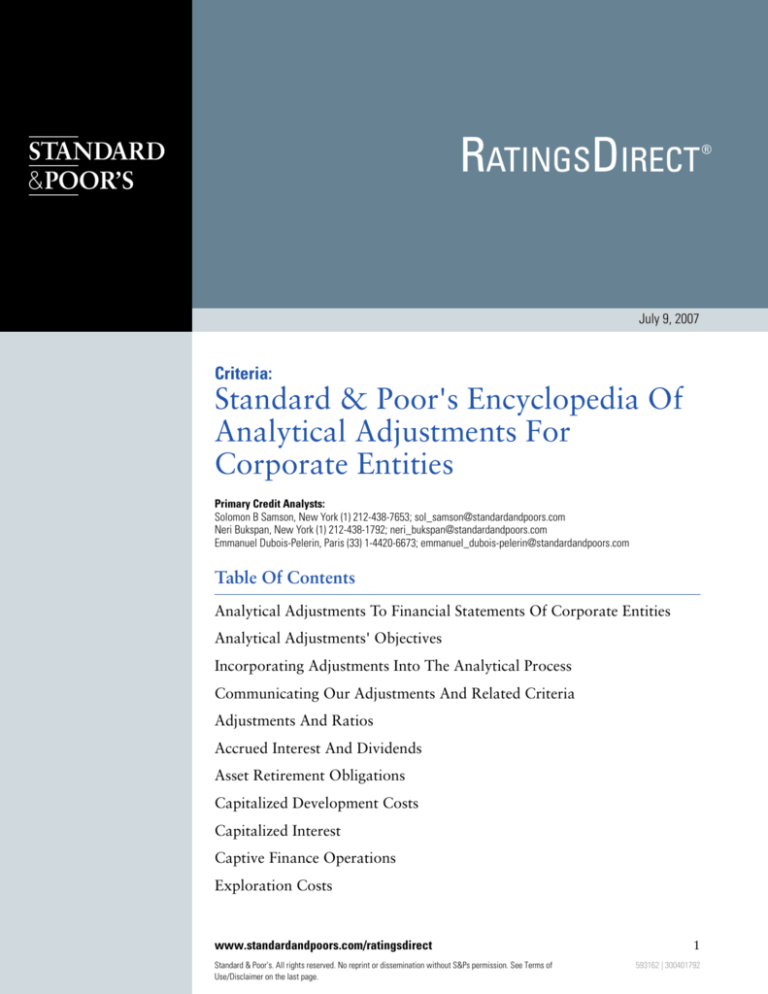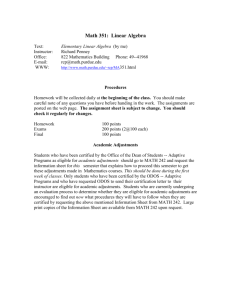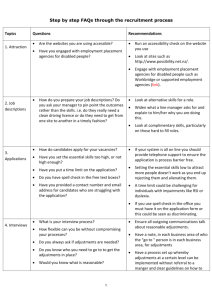
July 9, 2007
Criteria:
Standard & Poor's Encyclopedia Of
Analytical Adjustments For
Corporate Entities
Primary Credit Analysts:
Solomon B Samson, New York (1) 212-438-7653; sol_samson@standardandpoors.com
Neri Bukspan, New York (1) 212-438-1792; neri_bukspan@standardandpoors.com
Emmanuel Dubois-Pelerin, Paris (33) 1-4420-6673; emmanuel_dubois-pelerin@standardandpoors.com
Table Of Contents
Analytical Adjustments To Financial Statements Of Corporate Entities
Analytical Adjustments' Objectives
Incorporating Adjustments Into The Analytical Process
Communicating Our Adjustments And Related Criteria
Adjustments And Ratios
Accrued Interest And Dividends
Asset Retirement Obligations
Capitalized Development Costs
Capitalized Interest
Captive Finance Operations
Exploration Costs
www.standardandpoors.com/ratingsdirect
Standard & Poor's. All rights reserved. No reprint or dissemination without S&Ps permission. See Terms of
Use/Disclaimer on the last page.
1
593162 | 300401792
Table Of Contents (cont.)
Foreign Currency Exchange Gains/Losses
Guarantees
Hybrid Instruments
LIFO/FIFO: Inventory Accounting Methods
Litigation
Non-Recourse Debt Of Affiliates (Scope Of Consolidation)
Nonrecurring Items/Noncore Activities
Operating Leases
Postretirement Employee Benefits/Deferred Compensation
Power Purchase Agreements
Share-Based Compensation Expense
Stranded Costs Securitizations Of Regulated Utilities
Surplus Cash
Trade Receivables Securitizations
Volumetric Production Payments
Workers Compensation/Self Insurance
Key Ratios And Glossary Of Terms
Standard & Poor’s RatingsDirect | July 9, 2007
Standard & Poor's. All rights reserved. No reprint or dissemination without S&Ps permission. See Terms of
Use/Disclaimer on the last page.
2
593162 | 300401792
Criteria:
Standard & Poor's Encyclopedia Of Analytical
Adjustments For Corporate Entities
(Editor's Note: Credit analysts authorized to answer questions about these criteria are listed in table 3 at the end of
this report.)
Analytical Adjustments To Financial Statements Of Corporate Entities
Financial statement analysis is central to Standard & Poor's Ratings Services' rating methodology. Financial
statements, including the accompanying footnotes and disclosures, provide Standard & Poor's analysts with an
abundance of information incorporated in the determination and surveillance of ratings. But the issuer's financial
statements (historical or projected) are not necessarily viewed as "Truth"--i.e., the optimal or ultimate depiction of
the economic reality of the issuer's financial performance and position. The financial analysis process necessitates
making certain analytical adjustments to financial statements, to arrive at measures we believe are more reflective of
creditors' risks, rights, and benefits; enable more meaningful peer and period-over-period comparisons; and facilitate
more robust financial forecasts.
Adjusting financials long has been our practice, and is an integral part of the rating process. Although such
adjustments revise certain amounts reported by issuers under applicable Generally Accepted Accounting Principles
(GAAP), that does not imply that we challenge the application of GAAP by the issuer, the adequacy of its audit or
financial reporting process, or the appropriateness of GAAP accounting to fairly depict the issuer's financial position
and results for other purposes.
Rather, it reflects a fundamental difference between accounting and analysis. The accountant necessarily must find
one number to use in presenting financial data. The analyst, by definition, picks apart the numbers. Good analysis
looks at multiple perspectives--and utilizes adjustments as an analytical technique to depict a situation differently for
a specific purpose or to gain another vantage point.
Note that (adjusted) financial measures serve as a baseline for a much broader analytic process, in which we
consider a myriad of other financial and non-financial factors, both qualitative and quantitative. These include, to
name only a few: economic, regulatory, and geopolitical influences; management and corporate governance
attributes; key performance indicators; competitive trends; product-mix considerations; R&D prospects; patents
rights; and labor relations. To that end, supplementary interpretive nonfinancial and trend data, such as the
information provided in the Management Discussion & Analysis section of SEC filings, as well as data gathered
from our discussions with companies, other industry participants and experts, is essential.
We here summarize common adjustments we make to financial statements of global corporate entities reporting
under U.S. GAAP, International Financial Reporting Standards (IFRS), or substantially equivalent accounting
conventions. Although certain adjustments are refined or modified, this article introduces no material change in our
methodology or criteria.
The analytical rationale underlying our adjustments, and certain specifics of making them, can be found in Standard
& Poor's Corporate Ratings Criteria 2006, available at www.corporatecriteria.standardandpoors.com, and on
www.standardandpoors.com/ratingsdirect
Standard & Poor's. All rights reserved. No reprint or dissemination without S&Ps permission. See Terms of Use/Disclaimer on the last page.
3
593162 | 300401792
Criteria: Standard & Poor's Encyclopedia Of Analytical Adjustments For Corporate Entities
RatingsDirect, the real-time Web-based source for Standard & Poor's credit ratings, research, and risk analysis.
Analytical Adjustments' Objectives
The objectives relating to specific financial adjustments can be classified into one or more of the following
categories:
Facilitate comparability
Because the rating thought process is very much one of comparisons, it is important to have a common frame of
reference. Analytical comparisons encompass both peer comparisons, in which the issuer's performance and its
financial position are benchmarked against its peer group, as well as period-over-period comparisons, in which the
issuer's current performance is contrasted with that of the prior periods' results or budget or plan. Adjustments in
this category are intended to align accounting principles. Issuers' financials are adjusted where different options are
allowed under GAAP for similar transactions, or where the peer group is reporting under different accounting
conventions, for example, comparing companies using U.S. GAAP and IFRS.
Examples of accounting policy options existing within U.S. GAAP and/or IFRS:
•
•
•
•
•
•
•
Interest and other borrowing costs: capitalize or expense.
Jointly controlled entities: equity method or proportionate consolidation methods.
Property plant and equipment: depreciated cost or revaluation.
Investment property: reported at cost or fair value.
Inventories: First-In-First-Out (FIFO) or weighted-average-cost methods.
Pension and other defined benefit obligations: corridor deferral or on-balance sheet methods.
Financial assets: fair value and record the gains and losses currently in earnings or classify and account for as
held-to-maturity or available-for-sale.
• Financial liabilities: fair value through profit or loss or account under amortized or historical cost methods.
• Hedge accounting: apply hedge accounting or not. Additionally, there is always the implicit choice of opting out
of hedge accounting simply by not documenting them in the manner required as a prerequisite for hedge
accounting.
Facilitate period-over-period comparisons
Financials are adjusted where data reported in the current period are not comparable with that of past periods (e.g.,
when an acquisition or a change in accounting standards are accounted for prospectively, without restating the
prior-period statements, rendering unadjusted data comparisons meaningless).
Normalize different estimates and assumptions
Financials should be adjusted where the use of varying assumptions in deriving financial statements' amounts by
peer companies materially impacts the ability to make meaningful comparisons (e.g., divergent discount rates for
pension obligations; varying assets' useful lives estimates for depreciation purposes). However, in most cases, such
adjustments represent an ideal that is difficult to achieve, given a lack of sufficient data to enable recasting the
original information.
Comparability also is affected by varying financial statement formats/presentations--even if accounted for identically
with respects to methods and assumptions. Accordingly, we frequently reclassify items. For example, interest,
dividends, and tax cash flows that have been reported as investing or financing activities may be reclassified as
Standard & Poor’s RatingsDirect | July 9, 2007
Standard & Poor's. All rights reserved. No reprint or dissemination without S&Ps permission. See Terms of Use/Disclaimer on the last page.
4
593162 | 300401792
Criteria: Standard & Poor's Encyclopedia Of Analytical Adjustments For Corporate Entities
operating cash flow activities in order to avoid distorted comparisons.
Better reflect underlying economics
Adjustments in this category are intended to:
• Adjust where the accounting may diverge from our view of the economic substance of an underlying business
activity or transaction (e.g., to eliminate the smoothing effects of unrecorded post-retirement obligations, add
securitized assets and related obligations when we believe substantial risks are retained by the issuer, define the
appropriate consolidated group for analytic purposes, incorporate the potential outcome of a major contingency
or litigation, and recast operating lease-related measures).
• Adjust for underlying assumptions or estimates we view as overly aggressive, overly conservative, or not reflective
of the underlying economics.
Adjust for inconsistencies within accounting treatments
Even a single line item may include items valued under different approaches. For example, under IFRS or U.S.
GAAP, debt might include a bond valued at amortized cost, another whose value has been adjusted for fair value
hedge accounting by the amount of hedged risk, another that has been fully fair valued under the fair value option,
and yet another that had been brought to fair value when the subsidiary that issued it was acquired by the group
and subsequently has been amortized. In these situations, we generally will reflect the obligation at its par amount.
Better reflect creditors' risks and rights
Some adjustments address financial statement presentation that does not faithfully depict the relationship between
the enterprise and its creditors. It includes considerations of legal status and priority of obligations and claims (e.g.,
evaluation of consolidated subsidiary creditors' and minority investor rights).
Enhance forecasting
We evaluate financial data both retrospectively and prospectively. Retrospective analysis of financial statement data
is useful in evaluating an issuer's past performance compared with its peers or trends or budget. Prospective analysis
(i.e., forecasting) is critical in evaluating an issuer's ability to generate future resources sufficient to service its
financial obligations. To help make forecasts meaningful, it is important to adjust for certain past occurrences that
are not indicative of future performance (e.g., elimination of nonrecurring items). Another technique incorporates
actual or potential future events that likely would have altered the issuer's past performance on a pro forma basis.
Adjustments in this category might include the financial impact of a major acquisition or restructuring activity.
Incorporating Adjustments Into The Analytical Process
Our analysis of financial statements begins with a review of accounting characteristics to determine whether ratios
and statistics derived from the statements adequately measure a company's performance and position relative to
both its direct peer group and the larger universe of industrial companies. To the extent possible, our analytical
adjustments are made to better reflect reality and to minimize differences among companies.
Our approach to adjustments is meant to modify measures used in the analysis, rather than fully recast the entire set
of financial statements. Further, it often may be preferable or more practical to adjust separate parts of the financial
statements in different ways. For example, while stock-options expense represents a cost of doing business that must
be considered as part of our profitability analysis, fully recasting the cash implications associated with their grant on
operating cash flows is neither practical nor feasible, given repurchases and complexities associated with tax laws
www.standardandpoors.com/ratingsdirect
Standard & Poor's. All rights reserved. No reprint or dissemination without S&Ps permission. See Terms of Use/Disclaimer on the last page.
5
593162 | 300401792
Criteria: Standard & Poor's Encyclopedia Of Analytical Adjustments For Corporate Entities
driving the deduction timing. Similarly, the analyst may prefer to derive profitability measures from LIFO-based
inventory accounting--while retaining FIFO-based measures when looking at the valuation of balance sheet assets.
Certain adjustments are routine, as they apply to many of our issuers for all periods (e.g., operating lease,
securitizations, and pension-related adjustments). Other adjustments are made on a specific industry basis (e.g.,
adjustments made to reflect asset retirement obligations of regulated utilities and volumetric production payments of
oil and gas producing companies).
Beyond that, we encourage use of nonstandard adjustments that promote the objectives outlined above. Individual
situations require creative application of analytical techniques--including adjustments--to capture the specific fact
pattern and its nuances. For example, retail dealer stock sometimes has the characteristics of manufacturer
inventory--notwithstanding its legal sale to the dealer. Subtle differences or changes in the fact pattern (such as
financing terms, level of inventory relative to sales, and seasonal variations) would influence the analytical
perspective.
We recognize that the use of nonstandard adjustments involves an inherent risk of inconsistency. Also, some of our
constituencies want to be able to easily replicate and even anticipate our analysis--and nonstandard adjustments may
frustrate that ability. However, for us, the paramount consideration is producing the best possible quality analysis.
Sometimes, one must accept the tradeoffs that may be involved in its pursuit.
In many instances, sensitivity analyses and range estimates are more informative than choosing a single number.
Accordingly, our analysis at times is expressed in terms of numerical ranges, multiple scenarios, or tolerance levels.
Such an approach is critical when evaluating highly discretionary or potentially varied outcomes, where using exact
measurement is often impossible, impractical, or even imprudent (e.g., adjusting for a major litigation where there is
an equal probability of an adverse or a favorable outcome).
Similarly, in some cases, the analyst must evaluate financial information on an adjusted and an unadjusted basis. For
example, most hybrid equity securities fall in a grey area that is hard to appreciate merely by making numerical
adjustments. So, while we do employ a standard adjustment that splits the amounts in two, we also prefer that our
analysts look at measures that treat these instruments entirely as debt--and entirely as equity.
In any event, adjustments do not always neatly allow one to gain full appreciation of financial risks and rewards.
For example, a company that elects to use operating leases for its core assets must be compared with peers that
purchase the same assets (e.g., retail stores), and our lease adjustment helps in this respect. But we also recognize the
flexibility associated with the leases in the event of potential downsizing, and would not treat the company
identically with peers that exhibit identical numbers. Likewise, in a receivable securitization, while the sale of the
receivables to the securitization vehicle generally shifts some of the risks, often the predominant share remains with
the issuer. Beyond adjusting to incorporate the assets and related debt of the securitization vehicles, analysts must
appreciate the funding flexibility and efficiencies related to these vehicles and the limited risk transference that may
pertain.
Apart from their importance to the quantitative aspects of the financial analysis, qualitative conclusions regarding
the company's financial data can also influence other aspects of the analysis--including the assessment of
management, financial policy and internal controls.
Standard & Poor’s RatingsDirect | July 9, 2007
Standard & Poor's. All rights reserved. No reprint or dissemination without S&Ps permission. See Terms of Use/Disclaimer on the last page.
6
593162 | 300401792
Criteria: Standard & Poor's Encyclopedia Of Analytical Adjustments For Corporate Entities
Communicating Our Adjustments And Related Criteria
We traditionally have incorporated analytical adjustments to the ratings process. Our published key ratio statistics
are also adjusted to reflect many of the adjustments made (see Corporate Ratings Criteria 2006-- Ratings And
Ratios).
We recently established several processes intended to help those who use our ratings better understand the specifics
of those adjustments, with respect to both an individual company and the overall criteria underlying our adjustment
methodology.
Since 2003, we have published accounting sections that outline our view of the issuer's accounting characteristics,
including the underlying considerations and key adjustments made in our published industrial companies' issuer
reports. The purpose is to capture in one place the major accounting issues that affect an issuer's financials, their
related analytical significance, and the adjustments made; it is not intended to be a summary of every accounting
policy.
Recently, we commenced providing a reconciliation table in our credit analysis reports on corporate issuers. (See
New Reconciliation Table Shows Standard & Poor's Adjustments To Company Reported Amounts, published Oct.
3, 2006, on Ratings Direct.) This table provides a bridge between a company's reported amounts and various
Standard & Poor's adjusted measures. The reconciliation table begins with company reported amounts for a range
of balance sheet, earnings, and cash flow measures, then lists adjustments to each measure by topic and our total
adjusted measure. Not all adjustments are included as of yet in these reconciliation tables. We are modifying our
software to incorporate additional adjustments--but some adjustments may not be included, as they do not lend
themselves to precision or standardization (e.g., litigation or other contingencies).
Occasionally, adjustments are based in whole or in part on nonpublic information provided to us during the rating
process. Our rating analysis, evaluation, and commentary incorporate consideration of this information, but our
published data refer exclusively to publicly available information.
Our criteria governing financial-statement adjustments are subject to ongoing review and occasional revisions
necessary to address changes in accounting rules and in response to emerging financial products and
structures--consistent with our broad objective of maintaining a dynamic criteria framework capable of addressing
evolving market conditions in a timely and comprehensive manner.
When considering significant criteria changes (including ratio adjustments), we solicit public input and comments. In
addition, we encourage ongoing dialogue with market participants regarding all criteria matters. We regard this
dialogue as an important facet of maintaining a robust criteria framework, responsive to the needs of those who use
our ratings and other market participants.
Adjustments And Ratios
The following sections outline the specific adjustments we use in analyzing industrial companies. At the end, we
include our key ratios and their definitions. The list of adjustments, in alphabetical order, includes:
• Accrued Interest And Dividends
www.standardandpoors.com/ratingsdirect
Standard & Poor's. All rights reserved. No reprint or dissemination without S&Ps permission. See Terms of Use/Disclaimer on the last page.
7
593162 | 300401792
Criteria: Standard & Poor's Encyclopedia Of Analytical Adjustments For Corporate Entities
•
•
•
•
•
•
•
•
•
•
•
•
•
•
•
•
•
•
•
•
•
Asset Retirement Obligations
Capitalized Development Costs
Capitalized Interest
Captive Finance Operations
Exploration Costs
Foreign-Currency Exchange Gains/Losses
Guarantees
Hybrid Instruments
LIFO/FIFO: Inventory Accounting Methods
Litigation
Non-Recourse Debt Of Affiliates (Scope Of Consolidation)
Nonrecurring Items/Noncore Activities
Operating Leases
Postretirement Employee Benefits/Deferred Compensation
Power Purchase Agreements
Share-Based Compensation Expense
Stranded Costs Securitizations Of Regulated Utilities
Surplus Cash
Trade Receivables Securitizations
Volumetric Production Payment
Workers Compensation/Self Insurance
Accrued Interest And Dividends
Accrued interest that is not already included in reported debt is reclassified as debt. This adjustment allows more
consistent comparisons of companies' financial obligations, by eliminating differences arising from the frequency of
payments--for example, quarterly, rather than annually--or calendar dates of specific payments--for example,
January 1 or December 31.
In a similar vein, accrued dividends on hybrid equity securities are treated as debt, irrespective of the extent of their
equity content. (Deferred amounts--whether the deferral was optional or mandatory--are also usually treated as
debt, given the need to pay them in a relatively short time. Obviously, we would not include amounts that are
noncumulative, which never will be paid.)
Adjustment procedures
• Balance sheet: Accrued interest and dividends are reclassified as debt. There is no adjustment needed to equity.
• Cash flow statement: Since the impact is usually quite limited, no adjustment is performed. Annual cash flow is
not affected by payment frequency or dates, except in the year a particular security is issued or retired.
Asset Retirement Obligations
We treat asset retirement obligations (AROs) as debt-like liabilities. AROs are legal commitments, assumed when
commissioning or operating long-lived assets, to incur restoration and removal costs for disposing, dismantling or
decommissioning those assets. Examples include the costs of plugging and dismantling on- and off-shore oil and gas
Standard & Poor’s RatingsDirect | July 9, 2007
Standard & Poor's. All rights reserved. No reprint or dissemination without S&Ps permission. See Terms of Use/Disclaimer on the last page.
8
593162 | 300401792
Criteria: Standard & Poor's Encyclopedia Of Analytical Adjustments For Corporate Entities
facilities; decommissioning nuclear power plants and recycling or storing used nuclear fuel; and capping mining and
waste-disposal sites.
These commitments are independent from the level and timing of any cash flow generated by the use of the assets. In
certain instances, we expect ARO costs to be reimbursed to the entity through rates or assumed by other parties.
When the asset operator's costs are reimbursed by the government or via a rate-setting process, the entity bears far
different and less open-ended economic risks--and may not require debt imputation. We have tended to view AROs
related to nuclear power plants of rate-regulated U.S. utilities in this light.
Several characteristics distinguish AROs from conventional debt, including timing and measurement uncertainties;
tax implications; and the standing of claimants in bankruptcy.
ARO measurement involves a high degree of subjectivity and measurement imprecision. Our starting point is the
reported liability amount, which may be adjusted for anticipated reimbursements, asset salvage value, and tax
reductions, further adjusted for any assumptions we view as unrealistic.
Most AROs involve obligations to incur costs that may extend well into the future. Uncertainties inherent in their
estimation include:
• The amount of the ultimate cost of abandonment, which will depend on the relevant country's laws and
asset-specific environmental regulations at retirement; the condition of the markets for the specific assets'
retirement services; possible economies of scale for the operator; and whether the activities ultimately are
performed by the operator or by a third party.
• The timing of asset retirement, which is subject to assumptions that can change materially. For example, in
extractive projects, future price expectations for hydrocarbon or minerals affect the economic life of the assets.
For power generators, asset-retirement timing depends notably on local regulatory decisions. Their impact might
be favorable (i.e., in the case of an operating license extension) or unfavorable (i.e., in the case of an early
mandated closure).
• The discount rate to be used in the present value calculation. U.S. GAAP requires the use of an entity-specific
discount rate. Hence, the stronger the entity's credit, the lower the discount rate--and the higher the liability.
Similarly, the periodic accretion rate is lower for stronger credits, and higher for weaker credits. If nothing else,
this hinders comparability across companies using U.S. GAAP, as well as to IFRS-reporting companies, which use
market-related rates adjusted to risk-specific factors attributable to the liability.
AROs are recorded on a pretax basis under most accounting standards. Any expected tax benefits generally are
reflected as a separate deferred tax asset on the balance sheet (because the ARO-related asset is depreciated). Tax
savings, when they coincide with the ARO payments (as opposed to their provisioning), reduce the net cash cost,
which we factor in our analysis to the extent we expect the company to generate taxable income in the particular
jurisdiction.
• The obligation, net of any dedicated retirement-fund assets, salvage value, and anticipated tax savings, is added to
debt. We generally adjust for the net aggregate funding position, even if some specific obligations are
under-funded and others are over-funded.
• Adjustments are made on a tax-effected basis in cases where it is likely the company will be able to use the
deductions.
• The accretion of the obligation reflects the time value of money and is akin to non-cash interest--similar to
www.standardandpoors.com/ratingsdirect
Standard & Poor's. All rights reserved. No reprint or dissemination without S&Ps permission. See Terms of Use/Disclaimer on the last page.
9
593162 | 300401792
Criteria: Standard & Poor's Encyclopedia Of Analytical Adjustments For Corporate Entities
post-retirement benefit (PRB) interest charges. Accordingly, we reclassify it (net of earnings on any dedicated
funds, if applicable--but never less than zero) as interest expense for both income-statement and cash-flow
statement analysis. We keep the net present value of the obligations newly incurred during the period (analogous
to PRB service costs) within operating expenses. If dedicated funding is in place and the related returns are not
entirely reflected in reported earnings and cash flows, the unrecognized portion of the return on these assets is
added and the recognized portion is reclassified to interest expense and operating cash flow.
• Cash payments for abandonment and contributions into dedicated funds that exceed/are less than the sum of:
newly incurred obligations plus accretion of existing obligations are reclassified as repayment/incurrence of a debt
obligation; this increases/decreases operating cash flow and funds from operations by the difference.
• For U.S. rate-regulated utilities that own nuclear power plants included in rate base, we have concluded that the
decommissioning liability should not be viewed as an off-balance-sheet liability. This is because of the safeguards
that ensure funding sufficiency and collection of decommissioning costs in rates. Funding through customer rates
and the probable nature of recovery result in a substantive liability defeasance.
Adjustment procedures
Data requirements
•
•
•
•
•
•
The estimated asset retirement obligation (ARO), based on financial statement disclosure or analyst estimate.
Any associated assets or funds set aside for the ARO.
ARO interest costs, whether charged to operating or financing costs.
New provisions (increases in liability during the period).
Gain or loss on assets set aside for funding.
Cash payments for AROs.
Calculations
• Subtract assets set aside to fund asset-retirement liabilities from the ARO to create a net ARO.
• Multiply this net obligation by (1 - the tax rate) to create ARO debt.
• Subtract both the gain (loss) on assets set aside from the sum of new provisions and interest costs to arrive at the
excess contribution/shortfall.
• Multiply this excess contribution/shortfall by (1 - the tax rate) to arrive at the ARO adjustments to funds from
operations.
Procedures
• ARO debt is added to reported debt.
• ARO interest costs (net of ARO fund earnings) are removed from operating expenses and added to interest
expense.
• The ARO funds from operations figure is added to FFO.
(Please see Asset Retirement Obligations: How SFAS 143 Affects U.S. Utilities Owning Nuclear Plants, published
March 31, 2004, and Corporate Ratings Criteria 2006--Corporate Asset-Retirement Obligations, on RatingsDirect.)
Standard & Poor’s RatingsDirect | July 9, 2007
Standard & Poor's. All rights reserved. No reprint or dissemination without S&Ps permission. See Terms of Use/Disclaimer on the last page.
10
593162 | 300401792
Criteria: Standard & Poor's Encyclopedia Of Analytical Adjustments For Corporate Entities
Capitalized Development Costs
Costs relating to the conceptual formulation and design of products for sale or lease commonly are expensed on the
income statement--while costs incurred subsequent to establishing the technological feasibility of these products are
capitalized. The asset is then amortized over its estimated economic life.
Defining feasibility involves substantial subjectivity. Accordingly, the treatment of product or asset development
costs sometimes varies substantially among companies or accounting regimes. For example, many U.S. software
companies do not capitalize any software development costs (an analytically conservative approach), while others
capitalize certain expenditures and amortize them over future periods.
Expensing, rather than capitalizing, can have a meaningful impact on a company's financial statements and credit
metrics, making peer comparisons difficult. Automaker accounting for tooling poses similar comparability issues
relating to varying capitalization policies.
While it is acceptable under the applicable accounting rules for a company to capitalize certain development costs, in
order to facilitate comparability, we adjust reported financial statements. The amounts capitalized--net of
amortization of past capitalization--are treated as if they had been expensed. To the extent that the amortization of
past capitalization approximates current development costs, there is no impact on operating expenses, but there is
an impact on EBITDA.
This approach helps make companies' operating performance more transparent and comparable, regardless of their
stance on capitalizing software and similar development costs. Note, that with respect to energy exploration costs,
we take the opposite approach (see adjustment for exploration costs), given the objective of comparability with most
companies in that industry and the pragmatic aspects of doing so.
A company's position in its product life cycle has a great effect on its current spending relative to the amortization of
past capitalization of development costs. However, as a practical matter--in the absence of more accurate figures--we
use the annual amortization figure reported in the financial statements as a proxy for the current year's development
costs. We realize, too, that the amount amortized is not entirely comparable across companies, as the amortization
period for these assets may vary. For example, in the case of software, it typically ranges from two to five years.
Adjustment procedures
Data requirements
• Amount of development costs i







